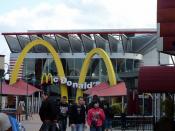Scholars have long been consumed with efforts to determine how the constructs of identity, image, reputation and brand are conceptually related and relevant in an organisational context. (Kärreman, 2008, 103) In today's commercial environment, large corporations face increasing pressure to manage the symbolic dimensions of their activities and thus the associated strategic implications, so this pursuit is made even more relevant (Dacin, 2006, 95) While researchers across several disciplines have explored these constructs, a significant dilemma in the study of these paradigms is that they are frequently misinterpreted or confused with each other. To fully elucidate their individual meanings, we can make use of large corporation McDonalds as a practical case-study. Through discussion and theoretical application, we can determine how the separate constructs of corporate identity image, reputation and branding differ, and critically assess their function in McDonald's corporate environment. Through this discussion we can then determine whether current corporate communication activities are sufficient, and what changes, if any, need to be made.
Unpacking the concept of corporate identity can prove difficult as there are so many divergent views on its precise definition, a debate which often lends itself to a theoretical 'fog' (Balmer, 2001.) While the lack of consensus is problematic, the contributions of academics from across various disciplines have combined to generate a broad multidimensional characterization which involves an interaction of business strategy, corporate philosophy, culture, behaviour and design (Van Reil, 1997) (Melewar, 2003, 200.) Originally corporate identity was viewed only from a 'graphic design' paradigm, being seen as having the sole purpose of 'increasing organisational visibility,' (Cornelissen, 2008, 65) Through both academic and historic development corporate identity is now more broadly determined through an 'understanding of an organisations mission, values, vision and culture' (Cornelissen, 2008, 67.) The 'summation of these (unique) tangible and intangible elements' (Zinkhan, 2001, 152) mean that corporate identity is not replicable, an effect which has been associated with 'superior business performance' (Zinkhan, 2001, 153) The blend of physical, operational and human characteristics and values (Topalian, 1984, 55) that manifest themselves through communications, behaviours, and 'stakeholder discourse' in the corporate environment (Balmer, 2001, 249) are central to this definition. Collective 'outward presentations' can be seen as the organisations 'ideal self-image,' or how a corporation perceives itself to be / wants to be perceived (Zinkhan, 2001, 153.) Identity cannot be falsely constructed and than any attempt to do so will have an unfavourable outcome (Cornelissen, 2008, 70), however organisations that ensure that their 'core values' are strongly defined and consistently communicated will maintain competitive advantage (Ibid,72).
Attributes that help to define an organisation's identity include symbolic and visual distinctiveness, strategic communication and organisational behaviour (Cornelissen, 2008, 66)(Ambiola, 2007, 341) Multinational corporation McDonald's serves as a perfect practical illustration of these features. Founded by American immigrant Ray Kroc in 1955, McDonald's is currently the world's largest fast-food chain, and has developed a prominent and highly distinctive visual identity during this time, as the 'golden arches' are recognisable in hundreds of countries (McDonalds Corporation, 2008.) With the stated mission 'to be our customers' favourite place and way to eat,' operations are orchestrated though a global strategy described as the 'plan to win. (Ibid)' This basic philosophy centres on the premise of 'exceptional customer service' which is instilled in all organisational members, and communicated through advertising strategies and workplace behaviours (Ibid). Quick service, inexpensive menu options and a strong emphasis on the universality of their product are all characteristics of their broader identity. As these elements are consistently and forcefully communicated in all markets they have entered, their corporate identity appears to be strongly defined.
As corporate image is the construct most frequently confused with that of identity, it is an important to clarify its correct meaning and explore why this confusion exits. As with the theoretical debate surrounding the notion of corporate identity, corporate image attracts similar dispute (Balmer, 2001, 243). Described as the subjective 'public reality' of an organisation, image differs from identity primarily because it is a reality as opposed to an ideal. (Abimbola, 200, 343) (Zinkhan, 2001) While corporate identity is considered to 'reside inside an organisation' image can be viewed as being formed in the external audience and stakeholders heads (Ibid) (Melewar, 2003, 200) Thus while identity is constructed from internal perceptions attitudes and behaviours, corporate image can be seen as the interpretation of these expressions. Another important distinction is that image is be perceived as an 'immediate impression in relation is a specific image or message' (Cornelissen, 2008, 70.) These impressions can managed through a variety of targeted communicative techniques, and this activity in considered an important objective (Ibid), as has been proven to increase market share, stakeholder loyalty, and reduce business risk (Zinkhan, 2001)For the proposed commercial advantages to eventuate, a company's image must be consistent with corporate identity, and this can pose a significant challenge as can be seen in the case of McDonalds. While the McDonald's corporate identity is well defined, its image is not, as many stakeholders maintain views which do not align with the ideal expressions of identity. Modern corporate activity often demands a 'compartmentalisation' of audience so specific messages can be tailored to each audience. The 'scattered image' phenomenon (Price, 2008, 173) results when organisations are pressured to communicate directly with segmented audiences, consequently creating varying messages and thus inconsistent images. Being such a large organisation, McDonald's has an enormous audience which effectively means there are an equal number of 'interpreters' to their projected identity. McDonalds recently adopted menu changes to include healthier options in order to reach a target audience. This move was criticised because of it incongruity with their broader identity as a fast food provide (Ibid, 180) Visibility also effects image management, and increases the likelihood of scrutiny. As McDonalds is an organisation that is often made representative of larger social issues, such as obesity, it attracts increased media attention (Hickman, 2006). This media attention increases the number of 'external arbiters' which propagate their own messages about the corporation and intercept the original messages communicated to stakeholders (Price, 2008, 173). A case in point is 'McSpotlight,' an independent group of volunteers which disseminate 'factual' but wholly negative information about McDonalds (Mc Spotlight, 2008). It can be seen that Image management while important will also continue to pose significant dilemmas for highly visible corporations like McDonalds.
Corporate reputation while distinct from the constructs of corporate image and identity can be described as the 'end goal' of image management, providing it with special relevance (Cornelissen, 2008, 73). Unlike the immediate impressions stakeholders make when developing a corporate image, corporate reputation is an 'evaluation of an organisation's image's made over time (Ibid). This 'enduring perception' has been likened to 'steady accumulation of evidence (Zinkhan, 2001, 155) that stakeholders use to form and overall judgements, (Balmer, 2001, 348) It is said be created from 'ongoing interaction between an organisation and key stakeholders groups,' generated through possible transactional experiences, targeted communications or random impact' (Ibid). Corporate image is far less 'durable' than reputation, thus a 'consistent store of goodwill and support' are important organisational objects (Llewellyn, G, 2002, 197). Because an organisation's identity is 'perceived and interpreted by its stakeholders' in terms of its image, the overarching goal of corporate identity management in an organisation is to acquire a favourable corporate image amongst the key stakeholders so that it can acquire a favourable corporate reputation (Cornelissen, 2008, 79). This not only results in stakeholders having a positive 'disposition' towards the organisation (Melewar, 2003, 200) but has strategic and financial advantages including increased profitability (Balmer, 2001, 290)While McDonalds may have a broad reputation as an efficient provider of fast-food with a strong commitment to corporate social responsibility (McDonalds corporation Australia, 2007), other enduring images and associated perceptions of such have meant that the desired reputation is not consistent among all stakeholder groups. Ensuring that key stakeholders' perceptions of a corporation are consistent with the projected images are vital elements of brand management (Balmer, 200, 290) Accordingly any 'gap' that exists between the two must be resolved (Harris, 2001, 443.) and this can be achieved by identifying and emphasising a corporation's distinctive values (Ibid). However, while the images McDonald's project may emphasise their corporate social responsibility initiatives which support and contribute to communities, the more salient images are still negative. Harmful media framing, films like 'Super size me,' criticising their practices, a number of lawsuits, and 'expose' books all pose significant challenges for the individuals managing the McDonalds reputation (Hickman, 2006). As McDonalds embodies several political and social issues, such as obesity and globalisation its reputation it ultimately bound to these, and they will factor in to the broader stakeholder judgments.
The notion of corporate branding is an emerging concept in this area of study as it finds its origins in the field of marketing (Kärreman, 2008.) It still shares links with the other constructs as it also is relevant to the practice of emphasising particular values associated with the organisation (Ibid). Development of a corporate brand requires a 'conscious decision by senior management' to refine and communicate the unique attributes of an organisation's identity to form of a 'defined branding proposition' (Balmer, 2001, 270). This 'proposition' is the framework for organisational efforts which 'communicate, differentiate, and enhance the brand' (ibid). Development of a corporate brand is a comprehensive organisational effort which demands involvement at every 'level of personnel'. Studies reveal that organisations that successfully practice corporate branding 'consistently align three interconnecting elements: strategic vision, organizational culture and corporate images' (Harris, 2001. 443). Successful branding efforts bring direction to an organization's communications and lessen the likelihood of contradictory messages being perceived (Zinkhan, 2001, 159)McDonalds is considered one of the world's most recognizable and prominent brands, ranked 9th 'best' in 2006 (Business Week, 2006). While there are many reasons for this, its ability to align the elements of strategic vision, organizational culture and corporate images is paramount. McDonald's uses its associations with prestigious global events, such as the Olympics, to reinforce its identity and visibility to stakeholder groups, and both advertising and high-profile corporate sponsorships have impact on its powerful corporate image. Employee's of McDonalds also undergo fairly rigorous training and are tutored in the ethos and attitudes of the company from their start, so a cohesive organisational culture is produced (McDonalds Corporation Australia, 2007). A coherent strategic vision whilst not as readily observable is still existent and all corporate literature points to a strong and unified organisational position (McDonalds Corporation International, 2008)While the constructs of corporate identity, image, reputation and branding have all been seen to have some practical application to the operation of McDonald's, there is some question as to whether management of such is adequate. The underlying wisdom in the literature that for the 'greater the alignment between these factors the more consistent and effective communication efforts will be' (Abimbola, 2007, 348) (Cornelissen, 2008, 73 ) Alignment thereby ensures that the 'images projected are appreciated by stakeholders,' in the way the organisation 'wants and aims to them be' thus consolidating its brand and fostering a favourable reputation (ibid). Unfortunately for McDonalds, the effort is made twice as difficult due to its prominence media and its embodiment of larger social issues. While McDonalds has a strong organisation identity, problems are encountered in image and reputation management as they do not always align with desired projections. Solutions or possible way to manage this issue could include developing better relationships with the media and increased projections of its identity through socially responsible programs and initiatives,. Whilst McDonalds may never entirely eradicate negative image perceptions, it can attempt to increase the favourable ones, thereby closing the gap between identity and reputation.
Through a critical assessment of the constructs of corporate identity, image, reputation and branding and their practical application in the form of the McDonalds case-study, many points of difference have been identified. Each construct requires careful management, and as observed in the case of McDonalds, one the most problematic areas of reputation and image management comes in the form of uncontrollable external influences. Thus the greater the commercial successes of a company, the greater the need for a company to mange its controllable internal resources and thus its desired image.
REFERENCE LISTAbimola, T, 2007, 'Brand, organisational identity and reputation in SMEs: an overview Qualitative Market Research 10:4, 341-48Acquaah , M, 2003, 'Organizational Competence and Firm-Specific Tobin's q: The Moderating Role of corporate reputation' Strategic Organization, 1, 383-411Balmer, J, 2001, 'Corporate identity, corporate branding and corporate marketing: seeing through the fog' European Journal of Marketing, 35:3, 248-291Business Week International, 2006 Top 100 Brands Cornelissen, 2008 'Corporate identity, corporate image, corporate reputation' Corporate Communication: A Guide to Theory and Practice, Sage Publications Ltd , 64-90Dacin, P & T, Brown, 2006, 'Corporate Branding, Identity, and Customer Response,' Journal of the Academy of Marketing Science, 34 (Spring), 95-98Harris, F, 2001, 'Corporate branding and corporate brand performance,' European Journal of Marketing, 35:3, 441-456.
Hickman, M Fast food titan McDonald's finds latest attack on its reputation hard to swallow,sThe Independent , 15 April 2006 Kärreman, D. & A. Rylander, 2008, Managing meaning through branding: the case of a consulting firm. Organization Studies, 29, 103-125Llewellyn, G, 2002, 'Corporate reputation: focusing on the zeitgeist', Business and Society, 41:4, 446-55Melewar, T, 2003, 'Determinants of the corporate identity construct: a review of the literature', Journal of Marketing Communications, 9, 195-220.
McDonalds Corporation International, 2008, McDonalds corporate information McDonalds Corporation Australia, 2007, Corporate Social Responsibility Report. McSpotlight, 2008 Who What Where Why, McDonalds fights off film attack, BBC United Kingdom, 15 June, 2004 Price, K., Gioia, D.A., Corley, K, 2008, 'Reconciling scattered images: Managing disparate organisational expressions and impressions', Journal of Management Inquiry, 173-183Simoes, C & S Dibb, Raymond P, 2005, 'Managing corporate identity: an internal perspective.' Journal of the Academy of Marketing Science, 33:2, 153-168Topalian, A., 1984, 'Corporate identity: beyond the visual overstatements', International Journal of Advertising, 3, 55-62.
Van Reil, C.B.M., & Balmer, J.M.T. 'Corporate Identity: The Concept, its Measurement and Management' European Journal of Marketing, 31:5Zinkhan, G., J Ganesh, J Anupam, & L Hayes , 2001, 'Corporate Image: A Conceptual Framework for Strategic Planning' Enhancing Knowledge Development in Marketing, 12, 152-160.


